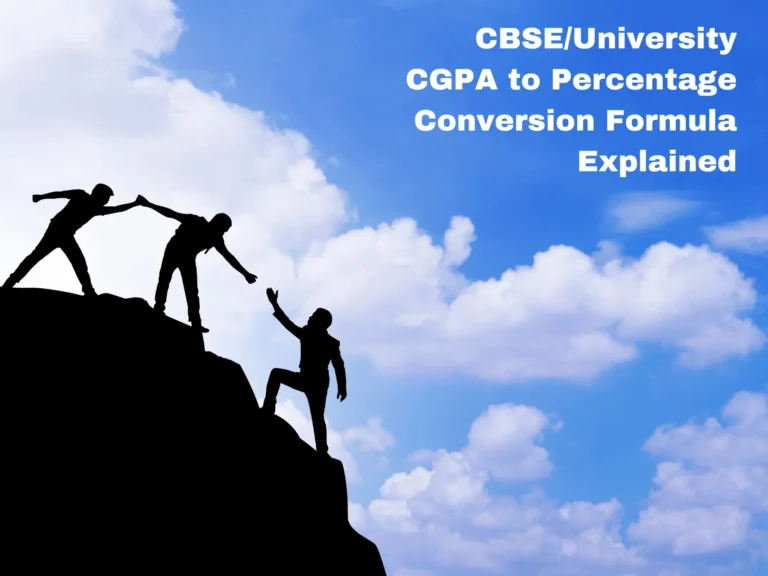Ask any student what stresses them out the most after exams, and you’ll hear this: “How do I convert my CGPA into percentage?”
It happens all the time. You get your result card with a neat CGPA, you feel good for a moment, and then—bam!—the college admission form or job portal asks for percentage. Suddenly you’re stuck googling formulas. That’s why it gets confusing. So let’s break it down properly.
First Things First: What is CGPA?
CGPA (Cumulative Grade Point Average) is basically your marks represented in grade points instead of numbers. Instead of saying you got 82 marks, your marksheet might just say 8.2 CGPA.
Why do schools do this?
- To reduce pressure on students.
- To make results more uniform.
- To shift the focus from marks to learning.
Sounds good, right? The only issue is that the real world still loves percentages. Colleges, scholarship forms, government exams, and even private companies. Most of them will ask you for percentage, not CGPA. That’s why you need to know the formula.
The CBSE Formula (Super Easy)
If you studied under CBSE, you’re in luck. CBSE has a simple, universal formula:
👉 Percentage = CGPA × 9.5
That’s it. Just multiply your CGPA with 9.5.
Examples:
- 8.2 CGPA → 8.2 × 9.5 = 77.9%
- 9.0 CGPA → 9 × 9.5 = 85.5%
This 9.5 factor isn’t random. CBSE decided on it after analyzing the marks and grade points of students for years. So yes, it’s official and reliable.

University CGPA to Percentage (Not the Same Everywhere)
Here’s where most students mess up. Universities don’t follow the CBSE rule. Every university or college has its own rules and principles that you need to follow. Here are a few well-known examples:
- Mumbai University
Formula: (CGPA – 0.75) × 10
Example: 8.0 CGPA → (8 – 0.75) × 10 = 72.5% - Anna University (Chennai)
Formula: CGPA × 10
Example: 7.5 CGPA → 75% - JNTU (Hyderabad)
Formula: (CGPA – 0.5) × 10
Example: 8.5 CGPA → 80% - Delhi University (DU)
Some colleges use CBSE’s × 9.5; others stick to their internal rulebook.
Note: Always double-check your respective university or college grading system.
Why Different Rules?
It may seem difficult or weird, but there are some facts behind this. Every university has its own:
- Paper difficulty
- Evaluation method
- Marking system
If everyone used the same formula, the percentages wouldn’t represent students fairly. That’s why each university tweaks the calculation to match its own system.
Quick CBSE Conversion Table
If you’re a CBSE student and don’t want to calculate every time, here’s a ready chart:
| CGPA | Percentage |
| 6.0 | 57% |
| 7.0 | 66.5% |
| 8.0 | 76% |
| 9.0 | 85.5% |
| 10.0 | 95% |
Mistakes Students Usually Make
A few slip-ups happen again and again:
- Using CBSE’s 9.5 multiplier for university CGPA (wrong!).
- Copying random formulas from Google without verifying.
- Rounding results too much (not a good idea for official forms).
If you’re filling out important applications, always double-check the official conversion rule.
CGPA vs Percentage – Which Matters More?
Honestly, neither is “better.” They’re just two different ways of showing the same performance.
- CGPA looks clean, less stressful, and avoids direct mark comparisons.
- Percentage is still the standard for most jobs, exams, and universities.
So you can’t escape conversion—it’s just something you need to know.
FAQs
Summary
You will find at the end that converting CGPA to percentage is a simple thing but you just need to know the formula. CBSE students → CGPA × 9.5. University students → Check your own institution’s guidelines. Both CGPA and percentage reflect the same performance in different ways. The next time someone asks, “What’s your percentage?”, you’ll know how to calculate it. No stress. No guesswork. Just the correct formula for your board or university.
